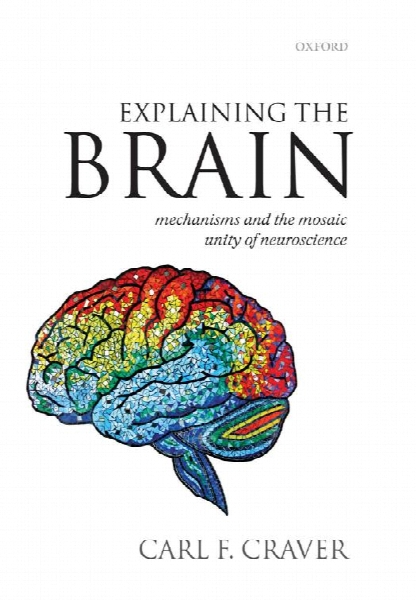Explaining the brain : mechanisms and the mosaic unity of neuroscience
- نوع فایل : کتاب
- زبان : انگلیسی
- مؤلف : Carl F Craver
- ناشر : Oxford : Clarendon, cop
- چاپ و سال / کشور: 2007
- شابک / ISBN : 9780199299317
Description
Preface; Chapter 1. Introduction: Starting With Neuroscience; 1 Introduction; 2 Explanations in Neuroscience Describe Mechanisms; 3 Explanations in Neuroscience are Multilevel; 4 Explanations in Neuroscience Integrate Multiple Fields; 5 Criteria of Adequacy for an Account of Explanation; Chapter 2. Explanation and Causal Relevance; 1 Introduction; 2 How Calcium Explains Neurotransmitter Release; 3 Explanation and Representation; 4 The Covering-Law Model; 5 The Unification Model; 6 But What About the Hodgkin and Huxley Model?; 7 Conclusion; Chapter 3. Causal Relevance and Manipulation; 1 Introduction; 2 The Mechanism of Long-Term Potentiation; 3 Causation as Transmission; 3.1 Transmission and Causal Relevance; 3.2 Omission and Prevention; 4 Causation and Mechanical Connection; 5 Manipulation and Causation; 5.1 Ideal Interventions; 5.2 Invariance, Fragility, and Contingency; 5.3 Manipulation and Criteria for Explanation; 5.4 Manipulation, Omission, and Prevention; 6 Conclusion; Chapter 4. The Norms of Mechanistic Explanation; 1 Introduction; 2 Two Normative Distinctions; 3 Explaining the Action Potential; 4 The Explanandum Phenomenon; 5 Components; 6 Activities; 7 Organization; 8 Constitutive Relevance; 8.1 Relevance and the Boundaries of Mechanisms; 8.2 Interlevel Experiments and Constitutive Relevance; 8.21 Interference Experiments; 8.22 Stimulation Experiments; 8.23 Activation Experiments; 8.3 Constitutive Relevance as Mutual Manipulability; 9 Conclusion; Chapter 5. A Field-Guide to Levels; 1 Introduction; 2 Levels of Spatial Memory; 3 A Field-Guide to Levels; 3.1 Levels of Science (Units and Products); 3.2 Levels of Nature; 3.21 Causal Levels (Processing and Control); 3.22 Levels of Size; 3.23 Levels of Composition; 3.231 Levels of Mereology; 3.232 Levels of Aggregativity; 3.233 Levels of Mere Material/Spatial Containment; 3.3 Levels of Mechanisms; 4 Conclusion; Chapter 6 Nonfundamental Explanation; 1 Introduction; 2. Causal Relevance and Making a Difference; 3 Contrasts and Switch-Points; 4 Causal Powers at Higher Levels of Mechanisms; 5 Causal Relevance among Realized Properties; 6 Conclusion; Chapter 7. The Mosaic Unity of Neuroscience; 1 Introduction; 2 Reduction and the History of Neuroscience; 2.1 LTP's Origins: Not a Top-Down Search but Intralevel Integration; 2.2 The Mechanistic Shift; 2.3 Mechanism as a Working Hypothesis; 3 Intralevel Integration and the Mosaic Unity of Neuroscience; 3.1 The Space of Possible Mechanisms; 3.2 Specific Constraints on the Space of Possible Mechanisms; 3.21 Componency Constraints; 3.22 Spatial Constraints; 3.23 Temporal Constraints; 3.24 Active Constraints; 3.3 Reduction and the Intralevel Integration of Fields; 4 Interlevel Integration and the Mosaic Unity of Neuroscience; 4.1 What is Interlevel Integration?; 4.2 Constraints on Interlevel Integration; 4.21 Accommodative Constraints; 4.22 Spatial and Temporal Interlevel Constraints; 4.23 Interlevel Manipulability Constraints; 4.3 Mosaic Interlevel Integration; 5 Conclusion: The Epistemic Function of the Mosaic Unity of Neuroscience
Preface; Chapter 1. Introduction: Starting With Neuroscience; 1 Introduction; 2 Explanations in Neuroscience Describe Mechanisms; 3 Explanations in Neuroscience are Multilevel; 4 Explanations in Neuroscience Integrate Multiple Fields; 5 Criteria of Adequacy for an Account of Explanation; Chapter 2. Explanation and Causal Relevance; 1 Introduction; 2 How Calcium Explains Neurotransmitter Release; 3 Explanation and Representation; 4 The Covering-Law Model; 5 The Unification Model; 6 But What About the Hodgkin and Huxley Model?; 7 Conclusion; Chapter 3. Causal Relevance and Manipulation; 1 Introduction; 2 The Mechanism of Long-Term Potentiation; 3 Causation as Transmission; 3.1 Transmission and Causal Relevance; 3.2 Omission and Prevention; 4 Causation and Mechanical Connection; 5 Manipulation and Causation; 5.1 Ideal Interventions; 5.2 Invariance, Fragility, and Contingency; 5.3 Manipulation and Criteria for Explanation; 5.4 Manipulation, Omission, and Prevention; 6 Conclusion; Chapter 4. The Norms of Mechanistic Explanation; 1 Introduction; 2 Two Normative Distinctions; 3 Explaining the Action Potential; 4 The Explanandum Phenomenon; 5 Components; 6 Activities; 7 Organization; 8 Constitutive Relevance; 8.1 Relevance and the Boundaries of Mechanisms; 8.2 Interlevel Experiments and Constitutive Relevance; 8.21 Interference Experiments; 8.22 Stimulation Experiments; 8.23 Activation Experiments; 8.3 Constitutive Relevance as Mutual Manipulability; 9 Conclusion; Chapter 5. A Field-Guide to Levels; 1 Introduction; 2 Levels of Spatial Memory; 3 A Field-Guide to Levels; 3.1 Levels of Science (Units and Products); 3.2 Levels of Nature; 3.21 Causal Levels (Processing and Control); 3.22 Levels of Size; 3.23 Levels of Composition; 3.231 Levels of Mereology; 3.232 Levels of Aggregativity; 3.233 Levels of Mere Material/Spatial Containment; 3.3 Levels of Mechanisms; 4 Conclusion; Chapter 6 Nonfundamental Explanation; 1 Introduction; 2. Causal Relevance and Making a Difference; 3 Contrasts and Switch-Points; 4 Causal Powers at Higher Levels of Mechanisms; 5 Causal Relevance among Realized Properties; 6 Conclusion; Chapter 7. The Mosaic Unity of Neuroscience; 1 Introduction; 2 Reduction and the History of Neuroscience; 2.1 LTP's Origins: Not a Top-Down Search but Intralevel Integration; 2.2 The Mechanistic Shift; 2.3 Mechanism as a Working Hypothesis; 3 Intralevel Integration and the Mosaic Unity of Neuroscience; 3.1 The Space of Possible Mechanisms; 3.2 Specific Constraints on the Space of Possible Mechanisms; 3.21 Componency Constraints; 3.22 Spatial Constraints; 3.23 Temporal Constraints; 3.24 Active Constraints; 3.3 Reduction and the Intralevel Integration of Fields; 4 Interlevel Integration and the Mosaic Unity of Neuroscience; 4.1 What is Interlevel Integration?; 4.2 Constraints on Interlevel Integration; 4.21 Accommodative Constraints; 4.22 Spatial and Temporal Interlevel Constraints; 4.23 Interlevel Manipulability Constraints; 4.3 Mosaic Interlevel Integration; 5 Conclusion: The Epistemic Function of the Mosaic Unity of Neuroscience


